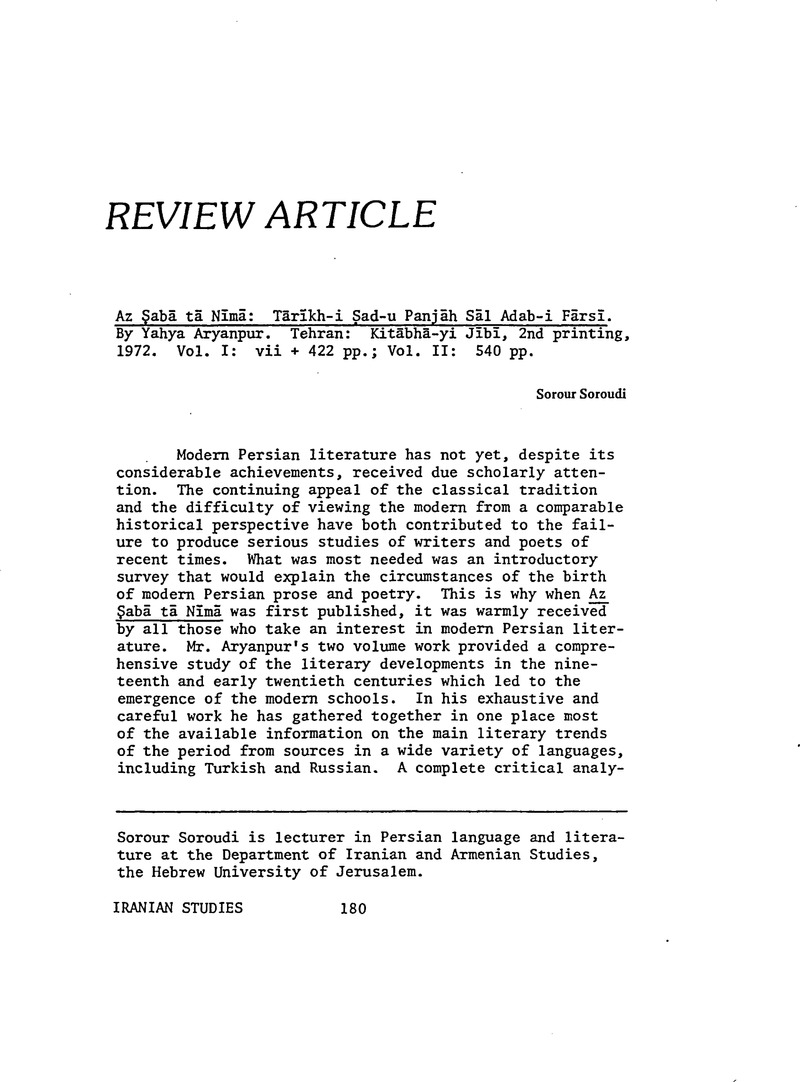No CrossRef data available.
Article contents
Az Ṣabā tā Nīmā: Tārīkh‐i Ṣad‐u Panjāh Sāl Adab‐i Fārsī. By Yahya Aryanpur Tehran: Kitābhā‐yi Jībī, 2nd printing, 1972. Vol. I: vii + 422 pp.; Vol. II: 540 pp.
Published online by Cambridge University Press: 01 January 2022
Abstract

- Type
- Review Article
- Information
- Copyright
- Copyright © Association For Iranian Studies, Inc 1976
References
Notes
1. There is some lack of correspondence between both the title and the subtitle of the book and its contents. The main title Az Ṣabā tā Nīmā (From Ṣabā to Nīmā) would rather suit a survey of poetry alone, since Ṣabā and Nīmā were main poetic figures at the beginning and the end of the period under discussion. However, since during this period poetry still maintained its prominence, one should not attach too much importance to this fact, although the work discusses both poetry and prose. The subtitle, on the other hand, is more encompassing than the work itself. Tārīkh-i Ṣad-u Panjāh Sāl Adab-i Fārsī (The History of a Hundred and Fifty Years of Persian Literature) creates the impression that the book covers all the literature created in Persian whether in Iran or abroad (Afghanistan, Pakistan, India, and Tajikistan). The addition of the words ‘in Iran’ to the subtitle would have prevented such misunderstanding.
2. However, I fail to see any justification for the division of this part into two chapters each covering one half of the nineteenth century, for nothing of importance occurred in the middle of the century to change or modify the course of the Return movement.
3. This is true of most, if not of all, of the court poets such as Ṣabā, Qā'ānī, Maḥmūd Khān and others.
4. The author makes other evaluations and judgments which leave much room for discussion and modification. For instance, Mr. Aryanpur's high esteem for Malkam Khān and his contributions is not shared by other scholars. See Nāṭiq, Humā “Mā va Mīrzā Malkam khānhā-yi Mā,” Nigīn, X, 115, pp. 35-43.Google Scholar
5. The same classical conservatism was one of the major obstructions to the modernization of poetry during the first half of this century.
6. The author does provide some examples of these folk poems when he discusses the works of ˓Ārif (II, pp. 154-159). However, the influence of folk poetry on the Constitutional poetry goes far beyond the works of ˓Ārif.
7. On their criticism of classical literature see Ādamīyyat, F. Andīshahā-yi Mīrzā Fatḥ ˓Alī Ākhūndzādah (Tehran, 1970), pp. 238-251Google Scholar; Mīrzā Āghā Khān Kirmānī, Kitāb-i Rayhān, unpublished manuscript, private library of Professor Mujtabā Mīnuvī, p. 6; also Nāẓim al-Islām Kirmānī, Tārīkh-i Bīdārī-yi Irāniān, introductory volume (Tehran, 1967), pp. 175-6.Google Scholar
8. See the works of Bahār, Pūr-Dāvūd, and Amīrī for examples of these responses during the Constitutional period.
9. In these cases the author could simply have referred the reader to Hāshimī's, M. S. four volume Tārīkh-i Jarāyid va Majallāt-i Īrān (Isfahan, 1948-54).Google Scholar
10. Some examples of Bahār's taṣnīfs are provided when the latter's works are discussed (II, pp. 347-349). This discussion does not release the author from the obligation to provide a comprehensive picture of the general subject (Constitutional taṣnīf) at least through references to other sections of the book.
11. For more examples of these taṣnīfs see Zhukovskii, V. A. Obraztsy Persidskago Narodnago Tvorchetsva (St. Petersburg, 1902).Google Scholar
12. The influence of folk poetry on Constitutional poetry was not limited to taṣnīf alone. Other genres and forms such as lullaby, parody, and tarānah were also adopted. For examples of parody see Nasīm-i Shumāl, Bāgh-i Bihisht (Tehran ed., n.d.), pp. 115-116Google Scholar; and of lullaby ibid., p. 83, and Īrān-i Naw, February 2, 1910, p. 1.
13. Other forms, however, even the rigid classical form of qasīdah were used to write topical poetry.
14. See Dihkhudā, M. A. Majmū ˓a-yj Ash ˓ār, ed. M. Mu˓īn (Tehran: Zawar, 1955), p. 127.Google Scholar
15. Although these rigid forms made a come-back in the post-Revolutionary period, they never regained their previous position.
16. For numerous examples, see Zhukovskii, op. cit., pp. 5-114.
17. This new outlook, as we shall see later, was not shared by all the poets.
18. Mr. Aryanpur's appraisal of Bahār's post-Revolutionary poetic works and beliefs is somewhat different from mine; see Az Ṣabā tā Nīmā, II, p. 338.
19. Similar sentiments were shared by most of the peoples of this region at the time of World War I.
20. These nationalistic tendencies were shared by many poets of the period, but Ibrāhīm Pūr-Dāvūd surpassed all the others in the extremity of his opinions.
21. See Soroudi, S. “The dispute of the ‘old and the new’ in modern Persian poetry,” Asian and African Studies, X, 1 (1974), pp. 25-38.Google Scholar




